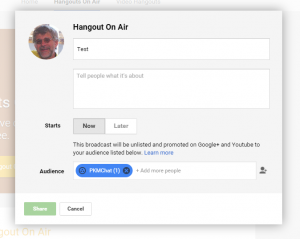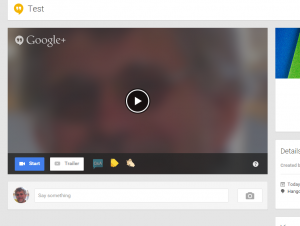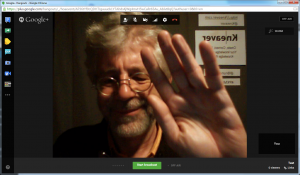I reached the extraordinary number of two interviews via Google Hangouts but already harvested tons of tips. Why not sharing them?
I will update this post as my list grows. Last tips will go at the end. This post is really organized as a simple list.
- Prepare, prepare, prepare again. The process is not complex but error prone so it is better to be totally ready at least one hour before.
- When starting a Google Hangout On air don’t be confused with plain Google Hangout. Both animals looks the same but are really different. Google Hangouts are not recorded and you can’t move from one to the other. So despite that the link to Google Hangout appears even on the bottom of the page to start a Google Hangout On air, don’t use it. The only way to start a Google hangout On air [aka GHOA hereafter] is to start an event of type GHOA on this link: https://plus.google.com/hangouts/onair.
- When creating the event you are asked:

- A Name. I keep it minimal because I’m often repeating this stage several times. It can be changed later. “Test” is great 🙂
- A description. I leave it empty.
- Starts: Now (means really ASAP)
- Audience: I remove Public and I add a group where I’m alone in it (don’t forget to invite YOURSELF), and the guest by his email AND it’s G+ handle. So it makes really three people on the invite. Note to self I could as well prepare the group with the guest in it.
- Start

- They prompt you again to invite more guests: you can skip. It’s possible to invite more guests on the fly using the toolbar on the top of the screen.
- Make sure at this stage that you are on the screen live (see why I wave my hand). It happened several times that only my picture was present. This is a sign that either: the camera is unreachable (Skype running!), you didn’t invite yourself, you didn’t use the proper link.

– Note:- top toolbar
- left toolbar
- picture in reversed
- broadcast is ready in green at the bottom
- you don’t hear yourself
- you can stay at this stage for hours, you aready to start as soon as your guest pop in.
- It’s better not to have youtube running in another window. I use a different logging and it could cause some interferences.
- As the interviewer OR the interviewee you must be logged onto GooglePlus to be accepted as invited. Otherwise it defaults to simple viewer and its difficult to find one’s way back. Onboarding guest is cumbersome because very often they end up being simple viewers. This is really the pain point IMHO.
- To use GHOA it requires a plugin, some software to download and install. As the interviewer, you are prepared and you will install it before. But make sure the interviewee understand it as well and click yes when he is asked to install it.
- Don’t script questions too tightly. It’s not a big deal to hesitate or do a confusion but it’s really cumbersome to watch someone reading his notes on the side of his computer. So improvisation applies. I prepare a deck. It is made of half pages (half of A4 or Letter size) hard paper printed in a large font. Once the interview starts I don’t touch my pen or my keyboard. I’m all listening. The deck will be placed on the keyboard, just below the screen. I can read quickly without moving my head.
Each card corresponds to a step.- Intro, before broacast when I wait and welcome the Interviewee Offline.
- Welcome and Thank You
- Make sure, again, to be understood that it will be recorded and gain acceptance.
- Let the interviewee do some audio and bandwidth tests on a few sentences. It must be continuous and over a minute to be meaningful. The best is to have something to let them read, anything will do.
- Explain what’s going to happen immediately next.
- Start Recording/Broadcast (same). Don’t forget this stage because if you don’t have viewers you may not realize it.
- You will have a warning if your mike is off.
- On air intro
- Welcome the Interviewee, gives her name, slowly and distinctfully (this is specially true for first language English speakers).
- Give her twitter handle name, web site address. This can be edited afterward and place on an annotation.
- Let her introduce herself.
- Thank again (publicly this time)
- Repeat the overall topic
- First question. A short sentence. Open question.
- On my deck I have a few followup prompts and a few reframing expressions on need.
- More questions, each on it’s card.
- Closing Card. This one justifies the whole deck. I’m easily distracted, especially if the conversation is interesting. With the deck on the keyboard I’m reminded of the sequence.
The last card will remind me to- Thank again the guest
- Repeat his name, twitter handle
- Let him add a closing remark
- Bye, bye
- Stop broacasting
- Intro, before broacast when I wait and welcome the Interviewee Offline.
- It seems that broadcast once stopped can’t be restarted. #NoteToSelf : have a spare event read to be started in case.
- After the recording the video will be on your youtube channel, unlisted if you made so when creating the event. Still it’s public. I turn it to private to allow rewiewing, adding a title, description. There are all the tools to trim it as well.
- Annotations are a nice addition. GaryV uses it a lot.
- Because my youtube account is verified and linked to my web site via webmaster, I can insert cards to my blog at critical moments.